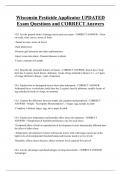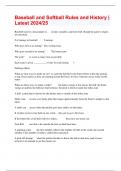Wisconsin Pesticide Applicator UPDATED Exam Questions and CORRECT Answers Ch.1 List the general kinds of damage insect pests can cause - CORRECT ANSWER - -Chew on seeds, roots , leaves, stems, & fruits -Tunnel in roots, stems, & leaves -Suck plant juices -Promote gall formation and other malformations -Inject toxins into plants -Transmit diseases to plants -Create a nuisance for people Ch.1 Describe the structural features of insects - CORRECT ANSWER - Insects have: body form has 3 regions: head, thorax, abdomen; 3 pairs of legs attached to thorax; 0, 1, or 2 pairs of wings attached to thorax; 1 pair of antennae Ch.1 Explain how to disti nguish insects from other arthropods - CORRECT ANSWER - Arthropods have: exoskeleton; body form has 2 regions: head & abdomen; usually 4 pairs of legs attached to head; no wings; no antennae Ch.1 Contrast the difference between simple and complete metamorp hosis - CORRECT ANSWER - -Simple: "Incomplete Metamorphosis"; 3 stages: egg, nymph, & adult -Complete: 4 distinct stages: egg, larva, pupa, & adult Ch.1 Explain how temperature and humidity affect insect development - CORRECT ANSWER - *Temperature & humidit y preferences vary for each insect. *Combined effect of both on reproduction & development is more dramatically different than the effect of either alone. -Temperature: development is faster with heat & slower with cold temps; insects die at the high level s of developmental threshold temps and become inactive at low levels -Humidity: effects insect diseases; effects moisture levels required for survival Ch.1 List the advantages and disadvantages of using insecticides - CORRECT ANSWER - Advantages: -Effecti ve against economically damaging pests -Can combine 1 or 2 insecticides to combat several pests -They act quickly to control pests before reaching damaging levels -For new pests, there are many compounds that have been proven effective -Effective insectic ides, suitable formulations, & application equipment are normally available Disadvantages: -Often eliminate beneficial insects, allowing target organisms to rebound quickly -Repeated exposure can lead to resistance in a pest population -Yearly dependence on applications is an added cost -Always a potential for drift, residues, and damage Ch.2 Explain what determines whether a given plant is a weed - CORRECT ANSWER - Weeds are unwanted plants Ch.2 List the two main goals of weed management - CORRECT ANSWER - 1. Minimize weed competition 2. Limit the weed's reproduction so that you can still manage the weed population in future years Ch.2 Describe ways that weeds can pose problems in turf and la ndscapes (7) - CORRECT ANSWER - -Interfere with management practices -Produce chemical inhibitors that directly retard the growth of desirable plants (allelopathy) -Create a poor impression on customers -Interferes with pesticide applications -Support insec t pests and plant diseases or provide cover for rodents -Are poisonous, allergenic, or irritating to people or pets -Dry out or die and become fire hazards Ch.2 Distinguish grasses from broadleaf plants and woody from herbaceous plants - CORRECT ANSWER - -Grasses (Monocots): most common weeds; have a single seed leaf (cotyledon) when they germinate; narrow leaves with parallel viens -Broadleaves (Dicots): have 2 seed leaves when they germinate; veins form a net -like or branching pattern; can be broken down into Woody and Herbaceous plants --> Woody: have thickened outer layer on stems (bark) --> Herbaceous: lacks bark Ch. 2 Describe the life cycles and propagation of annual, biennial, and perennial plants - CORRECT ANSWER - -Annuals: live less than 12 months ; most seeds germinate the following year, some are dormant taking several years; prolific seed producers. --> Summer Annuals: germinate from seed in spring, flower/produce seeds in summer, die in late summer/early fall. --> Winter Annuals: germinate from seed in fall, overwinter as low -growing plants, flower/produce seeds in spring, then die. -Biennials: live for 2 growing seasons; germinate from seeds in spring or summer and produce a rosette of leaves, overwinter in rosette stage, flower the following ye ar, produce seed, and die. -Perennials: live for at least 2 years, sometimes longer; may reproduce by seed or spread vegetatively (stolons, rhizomes, spreading roots, tubers, bulbs) Ch.2 Outline what is needed to kill annual, biennial, and perennial weeds and when it is easiest to do so - CORRECT ANSWER - -Annuals: kill the whole shoot by tillage or with herbicides during seeding stage. --> Summer Annuals: kill with tillage or herbicides during seeding stage. --> Winter Annuals: kill with tillage or herbici des during seeding stage. -Biennials: best controlled with herbicides during rosette stage. Perennials: controlled by repeatedly tilling or with herbicides that translocates to all plant parts. Ch.2 Distinguish the difference between preplant, preemergence, and postemergence herbicide applications - CORRECT ANSWER - -Preplant: done before planting. -Preemergence: usually (not always) done after planting but before plants/weeds emerge. -Postemergen ce: done selectively after plants/weeds emerge; timing is important; if the desirable plant is smaller or larger than the growth stage listed on the label, it may be damaged by the herbicide. Ch.2 Explain the effects of soil texture, organic matter, and p H and herbicide persistence on herbicide activity - CORRECT ANSWER - -Fine textured soils or soils with high organic matter often require higher herbicide rates than soils with coarser texture or low organic matter. -Some herbicides prohibit product use on certain soils with a light texture, low organic matter, or high pH to guard against excessive plant damage or herbicide persistence. -Excessive leaching on sandy soils with shallow water tables may result in groundwater contamination. Ch.2 Describe how an d when to make a basal -bark treatment - CORRECT ANSWER - -
Apply spray to lower 18 inches of stems -Thoroughly wet stem, crown, and exposed roots -Can make treatments throughout the year as long as the bark is not wet or when snow or water prevent spraying t o the ground Ch.2 Describe how and when to make an effective cut -stump treatment - CORRECT ANSWER - -Recommended for plants with thick bark or trunk is greater than 5 inches in diameter. -Thoroughly wet plant so runoff covers barks, crown buds, exposed roo ts, root collar, outer portion of cut surface. -Should be applied to cut surface before exposed plant tissue dries, within 2 -3 hours. Ch.2 List steps to take when applying herbicides to minimize adverse effects in urban areas - CORRECT ANSWER - -Prevent sp ray drift, drift of volatile products, runoff. -Spray when weeds are most susceptible so the minimum amount of herbicide results in maximum weed control. -Use less volatile formations -Apply on days when temps are less than 80 degrees F -Avoid spraying dur ing midsummer; garden plants and vegetables are more susceptible. -Avoid applying herbicides on dry, compacted soils -Keep pesticides off impermeable surfaces Chapter 2 Know the Law - CORRECT ANSWER - State and local laws require landowners to control cert ain weeds to prevent their spread and distribution Ch.3 Define plant disease and what causes it - CORRECT ANSWER - Any harmful change in the physiology and/or structure of a plant caused by some outside agent.





